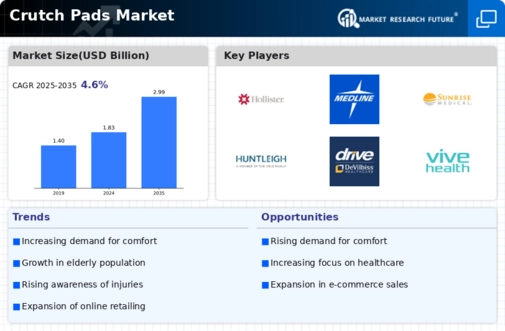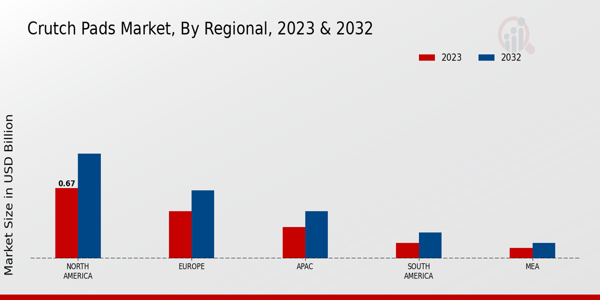Rising Healthcare Expenditure
The Global Crutch Pads Market Industry is positively impacted by the increasing healthcare expenditure observed globally. Governments and private sectors are investing more in healthcare infrastructure, which includes the provision of mobility aids for patients. This trend is particularly notable in developing countries, where healthcare systems are evolving to meet the needs of their populations. As healthcare expenditure rises, more resources are allocated to assistive devices, including crutches and their associated pads. This investment is expected to bolster market growth, as improved access to healthcare resources leads to a higher demand for quality mobility aids.
Growth of E-commerce Platforms
The expansion of e-commerce platforms significantly influences the Global Crutch Pads Market Industry. Online retailing provides consumers with greater access to a variety of crutch pads, allowing for informed purchasing decisions based on reviews and product comparisons. This shift towards online shopping is particularly appealing to individuals with mobility challenges, as it offers convenience and the ability to shop from home. As e-commerce continues to grow, manufacturers are likely to enhance their online presence, further driving sales. This trend aligns with the overall growth trajectory of the market, as more consumers seek accessible and comfortable mobility solutions.
Market Trends and Growth Projections
The Global Crutch Pads Market Industry is characterized by various trends that indicate a positive growth trajectory. The market is projected to reach 1.83 USD Billion by 2024 and is expected to grow to 2.99 USD Billion by 2035, reflecting a compound annual growth rate (CAGR) of 4.57% from 2025 to 2035. These figures suggest a robust demand for crutch pads driven by factors such as an aging population, technological advancements, and increased health awareness. The market dynamics indicate a favorable environment for manufacturers and retailers, as the need for comfortable and effective mobility solutions continues to rise.
Technological Advancements in Materials
Innovations in materials science significantly impact the Global Crutch Pads Market Industry. The introduction of advanced cushioning materials, such as memory foam and gel-infused pads, enhances user comfort and reduces the risk of skin irritation. These technological advancements not only improve the overall user experience but also extend the lifespan of crutch pads. Manufacturers are increasingly focusing on developing products that are lightweight yet durable, catering to the needs of diverse users. As a result, the market is expected to grow at a CAGR of 4.57% from 2025 to 2035, indicating a robust future driven by innovation.
Increased Awareness of Health and Safety
The Global Crutch Pads Market Industry benefits from heightened awareness regarding health and safety among consumers. As individuals become more conscious of the importance of using proper mobility aids, the demand for high-quality crutch pads rises. This awareness is often fueled by healthcare professionals who recommend specific products to enhance patient comfort and safety. Consequently, consumers are more likely to invest in crutch pads that provide adequate support and cushioning. This trend is anticipated to contribute to the market's growth, with projections indicating a rise to 2.99 USD Billion by 2035, reflecting the increasing prioritization of health and safety.
Rising Incidence of Mobility Impairments
The Global Crutch Pads Market Industry experiences growth driven by the increasing prevalence of mobility impairments among the aging population. As the global demographic shifts, a larger segment of the population requires mobility aids, including crutches. This trend is particularly evident in regions with aging populations, such as Europe and North America. The demand for crutch pads, which enhance comfort and usability, is likely to rise as more individuals seek solutions to improve their mobility experience. By 2024, the market is projected to reach 1.83 USD Billion, reflecting the growing need for supportive products in this sector.












